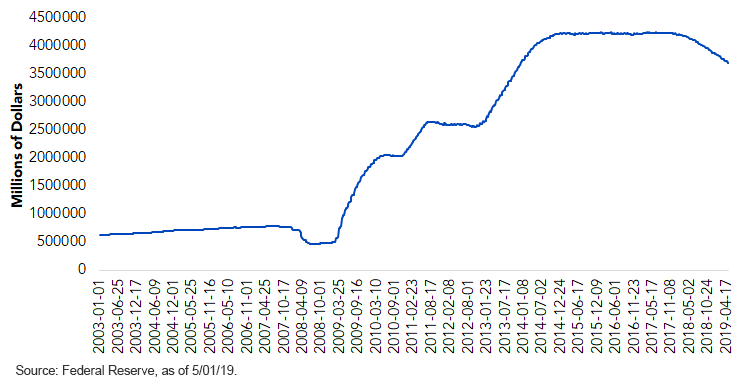No Longer “on the Q.T.”


I don’t want to bore you with just another blog post on the Fed. So, instead of debating whether the policy makers at the Fed should cut rates, stay on the sidelines or, dare I say it, raise rates, let’s turn our attention elsewhere … their balance sheet. The Fed has been embarking on a normalization path on this policy front since October 2017 by allowing predetermined amounts of its U.S. Treasury (UST) and agency debt and agency mortgage-backed securities (MBS) to roll off without being replaced. This drawdown in reinvestments can be considered the opposite of quantitative easing—or let’s call it quantitative tightening (QT). Effective this month, the FOMC put in place its “new” balance sheet plan, which is to end QT altogether later this year.
How about some perspective on the normalization plan? Heading into the Fed’s reinvestment drawdowns, securities held outright (UST, MBS, agency debt) on the balance sheet were placed at $4.24 trillion. As of this writing, Fed holdings of the aforementioned securities had fallen to $3.70 trillion, representing a decline of just under $540 billion (see graph). It is interesting to note that this drawdown was actually more than the Fed’s overall holdings back in late 2008/early 2009.
Fed Holdings of Treasuries, Agency Debt and MBS

So, what’s the plan going forward? The first step is to cut in half the monthly redemptions of Treasuries from a peak of $30 billion to $15 billion. This is the part of the plan I mentioned that began earlier this month. The agency debt and MBS drawdowns will remain the same at their current monthly pace of $20 billion. At the end of September 2019, the FOMC “intends to conclude the reduction of its aggregate securities holdings,” but the language is a little confusing because the Fed is really just ending the UST portion—the agency debt and MBS aspect will remain in place. However, the principal payments received from this drawdown will then be reinvested back into Treasuries beginning in October this year. These “new” UST purchases will be spread out across the yield curve to essentially “match the maturity composition” of Treasuries outstanding. Got that? Essentially, the plan is to try and get the Fed’s balance sheet more UST-centric going forward, and “limited sales of MBS might be warranted in the longer run” to achieve this goal.
Conclusion
While the money and bond markets continue to debate when, not if, the first rate cut is coming, the Fed has already taken its foot off the brake in a rather visible fashion. Think about it: the rate hike cycle seems to be on “perma-pause” while QT is now on its way of being eliminated. In other words, the U.S. economy will no longer be confronted by Fed headwinds.
Unless otherwise stated, all data is from the Federal Reserve as of May 1, 2019.


